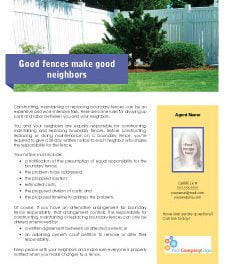Noxious environmental man-made hazards
Environmental hazards
- injurious to the health of humans; or
- an interference with an individual’s sensitivities.
In further analysis, environmental hazards which affect the occupant in their use and enjoyment of the property are either:
- located on the property; or
- originate from sources located elsewhere.
Hazards on the property
Environmental hazards located on the property which pose a direct health threat to occupants due to construction materials, the design of the construction, the soil or its location, include:
- asbestos-containing building materials and products used for insulation, fire protection and the strengthening of materials [Calif. Health and Safety Code §§25915 et seq.];
- formaldehyde used in the composition of construction materials [Calif. Civil Code §2079.7(a); Calif. Business and Professions Code §10084.1];
- radon gas concentrations in enclosed, unventilated spaces located within a building where the underlying rock contains uranium [CC §2079.7(a); Bus & P C §10084.1];
- hazardous waste from materials, products or substances which are toxic, corrosive, ignitable or reactive [Health & S C §25359.7; Bus & P C §10084.1];
- toxic mold [Health & S C §§26140, 26147];
- smoke from the combustion of materials, products, supplies or substances located on or within the building [Health & S C §§13113.7, 13113.8]; and
- security bars which might interfere with an occupant’s ability to exit a room in order to avoid another hazard, such as a fire. [CC §1102.16; Health & S C §13113.9]
Environmental hazards located off the property, but which have an adverse effect on the use of the property due to noise, vibrations, odors or some other ability to inflict harm, include:
- military ordnance sites within one mile of the property [CC §1102.15];
- industrial zoning in the neighborhood of the property [CC §1102.17];
- airport influence areas established by local airport land commissions [CC §§1103.4(c), 1353; Bus & P C §11010(b)(13); see RPI Form 308]; and
- ground transportation arteries which include train tracks and major highways in close proximity to the property.
Formaldehyde gas emissions
Formaldehyde is a colorless, pungent gas contained in most organic solvents which are used in paints, plastics, resins, pressed-wood fiberboard materials, urea-formaldehyde foam insulation (UFFI), curtains and upholstery textiles. Gas emitted from these materials and products contains formaldehyde.
Formaldehyde is a probable carcinogen which is likely to cause cancer in humans who inhale the gas emitted by formaldehyde-containing material.
The use of UFFI occurred in construction during the 1970s and was banned in residential property constructed after 1982. However, formaldehyde emissions decrease over time. As a result, properties built during the 1970s and early 1980s with formaldehyde-containing materials give off levels of formaldehyde no greater than newly constructed homes. Over time, emissions decrease to undetectable levels. However, an increase in humidity and temperature will increase the level of emissions.
Radon gas in soil
Radon is a naturally-occurring radioactive gas. It is not visible, cannot be tasted and has no odor. Radon gas
Radon is a known human carcinogen and enters a building from the soil beneath the structure.
Radon is sucked into ground floor residential space by interior heating on cold weather days and the use of exhaust fans in the kitchen and bathrooms since these conditions create a vacuum within the lower area of the structure.
However, California residences rarely experience elevated and harmful levels of radon gas emission. Radon does appear in approximately one percent of housing in California. Proper ventilation avoids the buildup of harmful concentrations of radon in a home or other enclosed space, a function of its design and operation.
Hazardous waste on site
Waste is hazardous if it has the potential to harm human health or the environment. Hazardous waste
Hazardous waste materials include any product, material or substance which is toxic, corrosive, ignitable or reactive, such as is generated by oil, gas, petrochemical and electronics industries, and dry cleaner and print shops.
Information is available to prospective buyers on their inquiry into the location and status of hazardous waste sites in the vicinity of a home from the “Cortese list” maintained by the California Environmental Protection Agency (EPA).
Mold: the rogue in vogue
Mold produces spores which become airborne. There are many different kinds of spores, each having differing effects, if any, on humans. Some may be a mere annoyance, irritating the sensitivities of an individual. Others might be a threat to the health of those who inhale them.
The uncertainty of the toxic nature of mold spores has led to a sort of intellectual moratorium on determining just what kinds of molds have an adverse or harmful effect on humans.
It has also spawned a number of lawsuits as the unknown nature of “toxic mold” has been allowed by politicians and lawyers to stir the fears of the general public.
Sellers are under no obligation to investigate whether the improvements contain mold. If it is known the structure does contain mold, the seller has no obligation to determine if the mold is a threat to human health.
The DHS has not yet set any standards for disclosures regarding the existence of mold or guidelines for the remediation of mold threats. However, the DHS has published multiple consumer-oriented booklets on mold on its website at www.cdph.ca.gov.
Until uniform disclosure standards are produced and implemented, the prospective buyer will receive only a generic informational brochure and a writing from the seller and the seller’s agent in the form of a transfer disclosure statement (TDS) advising the buyer of any awareness or knowledge the seller or the seller’s agent may have that mold exists on the property. No common knowledge exists for sellers or seller’s agents to visually distinguish between harmful and benign molds.
If the seller is aware of mold, regardless of type, the seller is to disclose any awareness of the mold’s existence, as well as any other reports or knowledge about the variety of mold which exists.














